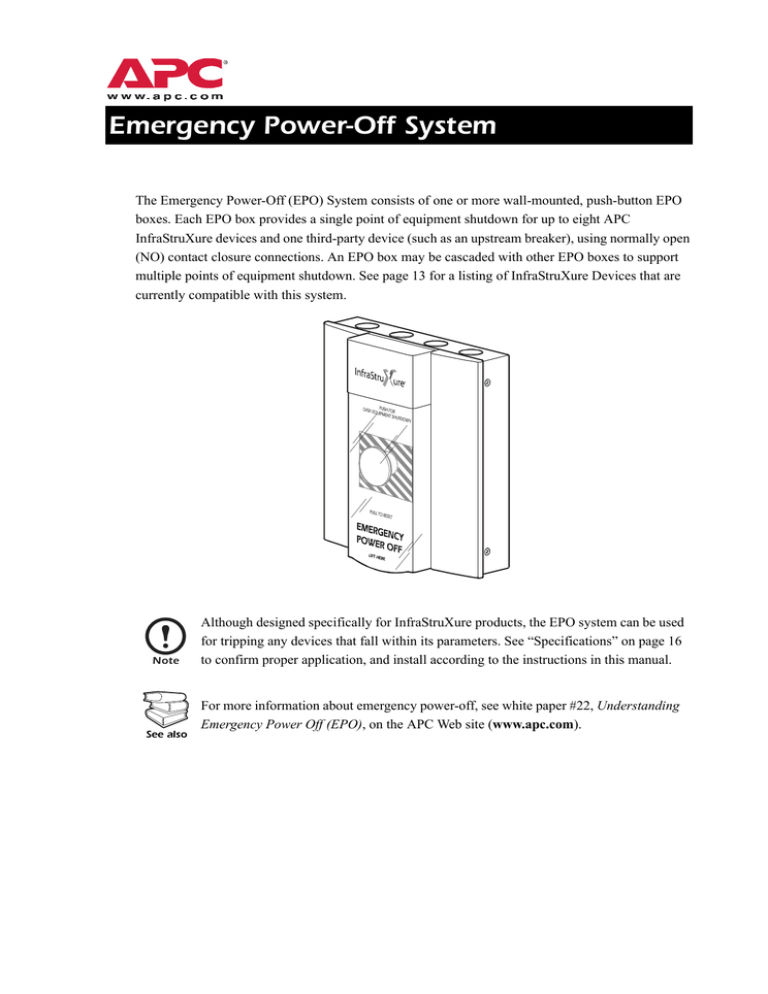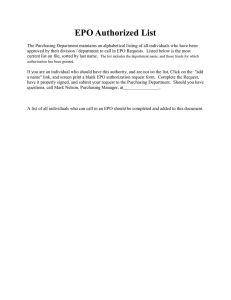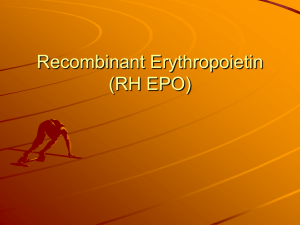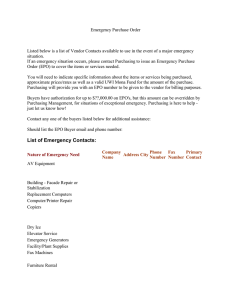
Emergency Power-Off System
The Emergency Power-Off (EPO) System consists of one or more wall-mounted, push-button EPO
boxes. Each EPO box provides a single point of equipment shutdown for up to eight APC
InfraStruXure devices and one third-party device (such as an upstream breaker), using normally open
(NO) contact closure connections. An EPO box may be cascaded with other EPO boxes to support
multiple points of equipment shutdown. See page 13 for a listing of InfraStruXure Devices that are
currently compatible with this system.
Note
See also
Although designed specifically for InfraStruXure products, the EPO system can be used
for tripping any devices that fall within its parameters. See “Specifications” on page 16
to confirm proper application, and install according to the instructions in this manual.
For more information about emergency power-off, see white paper #22, Understanding
Emergency Power Off (EPO), on the APC Web site (www.apc.com).
Contents
Overview . . . . . . . . . . . . . . . . . . . . . . . . . . . . . . . . . . . . . . . . . 1
Safety . . . . . . . . . . . . . . . . . . . . . . . . . . . . . . . . . . . . . . . 1
EPO box components . . . . . . . . . . . . . . . . . . . . . . . . . . . . . 2
Installation . . . . . . . . . . . . . . . . . . . . . . . . . . . . . . . . . . . . . . . . 3
Open the EPO System box . . . . . . . . . . . . . . . . . . . . . . . . . 3
Mount the system on a wall . . . . . . . . . . . . . . . . . . . . . . . . 3
Connect devices to the EPO box . . . . . . . . . . . . . . . . . . . . . 7
Mount additional EPO boxes . . . . . . . . . . . . . . . . . . . . . . . . 7
Cascading multiple EPO boxes . . . . . . . . . . . . . . . . . . . . . . . 8
Direct wiring alternative . . . . . . . . . . . . . . . . . . . . . . . . . . 10
Verify connections at each EPO box . . . . . . . . . . . . . . . . . . 11
Operation . . . . . . . . . . . . . . . . . . . . . . . . . . . . . . . . . . . . . . . . 12
APC InfraStruXure Devices . . . . . . . . . . . . . . . . . . . . . . . . . . . . 13
Mounting Hole Template . . . . . . . . . . . . . . . . . . . . . . . . . . . . . 14
Wiring Diagram. . . . . . . . . . . . . . . . . . . . . . . . . . . . . . . . . . . . 15
Specifications . . . . . . . . . . . . . . . . . . . . . . . . . . . . . . . . . . . . . 16
Warranty and Service . . . . . . . . . . . . . . . . . . . . . . . . . . . . . . . 17
Limited warranty . . . . . . . . . . . . . . . . . . . . . . . . . . . . . . . 17
Warranty limitations . . . . . . . . . . . . . . . . . . . . . . . . . . . . 17
Obtaining service . . . . . . . . . . . . . . . . . . . . . . . . . . . . . . 17
EPO System—Installation and Operation
i
Overview
Safety
Save these instructions. This manual contains important instructions that should be followed during
installation and maintenance of the system.
Safety instructions for North America and Canada
Electrical
Hazard
Note
Caution
Only a certified electrician can install the system and the wiring to the products it
controls.
Wiring from the system to the products it controls can either be installed in conduit or
installed without conduit if the wires are in accordance with Article 725 of the National
Electrical Code (NFPA 70) and Section 16 of the Canadian Electrical Code (C22.1).
Only Class 2 circuits rated 30 V or less shall be connected to terminals 1–8. Class 2
circuits are defined in Article 725 of the National Electrical Code (NFPA 70) and
Section 16 of the Canadian Electrical Code (C22.1). A Class 2 circuit is a source having
limited voltage and energy capacity as follows:
a. If an Inherently Limited Power Source, voltage is limited to 30 VAC or 30
VDC, and energy is limited to 8 A.
b. If not an Inherently Limited Power Source, voltage is limited to 30 VAC or 30
VDC, energy is limited to 250 VA, and current is limited to 1000/Vmax. The
fuse is limited to 5 A if maximum voltage is 20 V, or 100/Vmax if voltage is
greater than 20 V but less than 30 V.
EPO System — Installation and Operation
1
Overview
Safety instructions for Europe, Middle East, and Africa
Electrical
Hazard
Note
Caution
2
Only a certified electrician can install the system and the wiring to the products it
controls.
Wiring from the system to the products it controls can either be installed in conduit or
without conduit if the wires are in accordance with IEC/EN 60364-5-52 or equivalent
local electric code.
EPO can be achived with either a contact closure or application of an external 24VAC or
24VDC from a SELV or PELV source. It is important to note that hazardous voltage
from the Mains voltage must be isolated from the contact closure or 24VAC, 24VDC.
The EPO circuit contact closure, the 24VAC, or the 24VDC are considered a SELV
circuit as defined in EN60950 “Safety of Information Technology Equipment” or PELV
circuit as defined in IECDD 60364-4-41 “Electrical Installations of Buildings Protection
for Safety—Protection Against Electric Shock.” SELV is an abbreviation for Safety
Extra Low Voltage. PELV is an abbreviation for Protective Extra Low Voltage. SELV
and PELV circuits are isolated from the Mains through a safety isolating transformer,
and designed so that under normal conditions the voltage is limited to 42.4Vpeak or
60VDC.
EPO System — Installation and Operation
Overview
EPO box components
$
! Flag
" Button
# Shield
#
$ Knock-outs
"
% Mounting holes
& Blanking panels
!
' Wire anchors
%
( Auxiliary device terminal
) InfraStruXure device terminal block
* Cascading jacks
&
+ Wiring check points
'
, Ground stud
(
- Cable clamps
)
*
-
,
+
Wiring, conduit, and mounting hardware are not provided.
Note
EPO System — Installation and Operation
3
Installation
Open the EPO System box
Remove the screws on the side of the box and open. Keep the screws for after the system is installed.
The box will not close securely without the screws in place.
Mount the system on a wall
Mount the system in a readily-accessible area, on a wall near the principal entrance doors, according
to NEC articles 645.10 and 645.11, IEC/EN 60354-5-537, or equivalent local regulation. There are
two different procedures for mounting the system, depending on if you are running conduit along the
wall (page 4) or behind the wall (page 5).
Note
4
In countries where conduit is not used, run the cables from the connected devices or
the cascaded EPO boxes directly to the EPO using Shielding Troughs and Cable
Ladders.
EPO System — Installation and Operation
Installation
If you are running conduit (or cables) along the wall.
1. Use four ¼-inch (6.35-millimeter) screws and fasten the
screws through the four mounting holes at each corner of
the EPO box and into the wall. (See page 14 for a
template.)
2. Run the conduit (or cables for the connected devices) to the
EPO box. The conduit will contain all wiring from the
connected devices and all cascading cables. The knockouts
in the top and bottom of the EPO box accept .- (13-) and
/-(19-) inch (millimenter) conduit or clusters of cables.
Remove the knockouts required for your installation.
Note
When planning your conduit requirements,
consider that two cascading cables will fit in
.-inch (13-millimeter) conduit and four
cascading cables will fit in /-inch (19millimeter) conduit. See “Cascading multiple
EPO boxes” on page 8 for more information.
3. Install an appropriate fitting with a lock-nut for each
knockout that you are using.
4. Connect your conduit (or cables) to the fittings.
EPO System — Installation and Operation
5
Installation
IIf you are running conduit (or cables) behind the wall.
1. Install a junction box behind the wall. The EPO box will fasten directly to the junction box. You
can use one of the following options:
One 4-inch square junction box
Two 4-inch square junction boxes
One switch box up to 4-gang in size
2. Run the conduit (or cables from the connected devices) to the junction or
switch box. The conduit will contain all wiring from the connected
devices and all cascading cables. Remove the knockouts required for your
installation.
Note
When planning your conduit requirements, consider that two
cascading cables will fit in .-inch (13-millimeter) conduit
and four cascading cables will fit in /-inch (19-millimeter)
(conduit. See “Cascading multiple EPO boxes” on page 8 for
more information.
3. Install an appropriate fitting with a lock-nut for each knockout that you are
using.
4. Connect your conduit (or cables) to the fitting.
5. Remove one or both of the blanking panels covering the
window in the back of the box, as required.
6
EPO System — Installation and Operation
Installation
6. Secure the EPO box directly to the junction or
switch box with the appropriate number of
6-32 screws around the access window.
7. Reinforce the EPO box with 0-inch (6.35millimeter) screws in the corner mounting
holes. (See page 14 for a schematic of the EPO
box mounting holes.)
Note
The top two 0-inch (6.35millimeter) mounting holes may be
blocked by some junction boxes. In
this instance, use only the bottom
two 0-inch (6.35-millimeter)
mounting holes for reinforcement.
EPO System — Installation and Operation
7
Installation
Connect devices to the EPO box
Terminals 1–8 are for connecting to APC InfraStruXure devices. Terminal 9 is for connecting to an
auxiliary device. Connect only one wire pair (24–18 AWG) to each terminal block.
1. Attach EPO circuits to each InfraStruXure device
according to the specific instructions for that device.
Use the normally open (NO) contact option.
2. Run suitable wire (24–18 AWG) from the
InfraStruXure devices through the conduit to terminals
1–8 on the EPO box terminal block.
Note
Make the connections to the terminal
block in numerical order (terminal 1, and
then terminal 2, etc.).
3. Run suitable wire (22–18 AWG) from the contact
closure points for any auxiliary device through the
conduit to terminal 9 on the EPO box terminal block.
The auxiliary circuit is rated 1A at
48VDC/240VAC.
Note
4. If necessary, secure wires inside the box using the releasable wire ties (provided). Thread the
wire ties through the square wire anchors in the box.
5. Connect a suitable ground or PE wire to the #832 ground stud in the lower left corner of the
EPO box.
Mount additional EPO boxes
To mount additional EPO boxes at other exit doors, follow the instructions in “Mount the system on a
wall” on page 3. You have two alternatives for wiring your additional EPO boxes. You can cascade
the boxes so that you only wire devices to one box (see page 8), or you can wire devices directly to
each EPO box (see page 10).
8
EPO System — Installation and Operation
Installation
Cascading multiple EPO boxes
When cascading EPO boxes, connect a wire pair from each device to the first EPO box according to
the procedure in “Connect devices to the EPO box” on page 7. Jumper the subsequent EPO boxes
with cascading cables (standard Cat-5 cable)— this will join the EPO boxes in parallel.
In fra S tru X u re
D e v ice
In fra S tru X u re
D e v ice
A u x ilia r y
N o n -In fra S tr u Xu r e
B re a ke r
In fra S tru X u re
D e v ice
In fra S tru X u re
D e v ice
12 3 4 5 6 789
12 3 4 5 6 789
C AT-5
EPO Bo x 1
12 3 4 5 6 789
C AT-5
EPO Bo x 2
EPO Bo x 3
In fra S tru X u re
D e v ice
In fra S tru X u re
D e v ice
In fra S tru X u re
D e v ice
In fra S tru X u re
D e v ice
The recommended maximum total distance of wire you can run per circuit is 1000 feet
(300 meters).
Note
EPO System — Installation and Operation
9
Installation
Cascade the InfraStruXure devices with Cat-5 cables. Connect the Cat-5 cables to the jacks
inside the EPO box. Each cable can support up to four InfraStruXure device wire pairs. Follow these
guidelines when connecting Cat-5 cables:
• Use only the bottom jacks (# and $)
if you are cascading four or fewer
InfraStruXure devices.
• Use both the bottom and the top jacks
(!, ", #, and $) if you are
cascading five or more InfraStruXure
devices.
Box 2
Box 1
O u tp u t
!
"
#
$
• Connect the output jacks (! and #)
of the first EPO box to the input jacks
(" and $) of the second EPO box.
• Continue until all boxes are connected.
• If necessary, use the white cable clamps to secure the Cat-5 cables.
Cascade the auxiliary device with wire pairs. After you have ran
wires from your auxiliary device (!) to terminal block position 9, run a
second set of wires (") from terminal block position 9 on the first EPO
box to terminal block position 9 on the second EPO box. Continue until
all boxes are connected. (See the diagram on page 8 for reference.)
10
In p u t
EPO System — Installation and Operation
Installation
Direct wiring alternative
If the InfraStruXure devices are centrally located between exit doors, it may be more practical to run
separate wire pairs from the devices to each EPO box. This requires terminal block connections in
every EPO box, rather than cascading cables between boxes.
Connect wire pairs from the Normally Open (NO) contacts on the InfraStruXure devices to each EPO
box. Because this alternative results in multiple wire pairs at the terminals of the InfraStruXure
devices, it is not recommended for use with more than three EPO boxes.
In fra S tru X u re
D e v ice
In fra S tru X u re
D e v ice
In fra S tru X u re
D e v ice
12 3 4 5 6 789
EPO Bo x 1
12 3 4 5 6 789
A u x ilia r y
N o n - In fra S tru X u re
B re a k e r
EPO System — Installation and Operation
EPO Bo x 2
11
Verify connections at each EPO box
1. Verify that the wiring is correct before attaching critical load devices to your InfraStruXure
devices:
a. With the devices powered ON, use a small tool to
press each check point, one at a time.
Warning
Note
Pressing the check point will shut
down the connected device and any
load it is supporting.
If you have an APC FM Series Precision
Air Conditioning System connected,
pressing the check point will shut off
functionality to the unit, but it will still
be powered.
b. After you have verified the wiring, close the system
box, making sure not to pinch wires or disturb
connections, and secure with the screws you
previously removed.
c. As a final test, apply power to all InfraStruXure and auxiliary devices, and then press the
EPO button. All connected devices should power OFF immediately. Repeat this final test at
every EPO box in your system.
The InfraStruXure PDUs have an EPO test feature that verifies EPO operation without
shutting down the connected loads. Refer to your PDU operation manual for details.
See also
12
EPO System — Installation and Operation
Operation
To engage the system: Lift the shield on any of the boxes that are installed and press the button.
When you lift the shield, a red flag drops down from the box to indicate that the shield on the EPO
box has been opened, so that if the button is engaged, you will have an easy visual mark as to which
EPO box in your room has been activated.
To reset the EPO system: Pull the button toward you. Pulling the button does not bring power back
to connected equipment; it only resets the EPO system.
To close the shield: Push the flag (!) back up into the box and snap the shield tight (").
"
!
To reset your equipment: Apply power to your devices according to the procedures for each device.
EPO System — Installation and Operation
13
APC InfraStruXure Devices
The list below is a selection of compatible APC InfraStruXure devices that you can connect to the
EPO system.
InfraStruXure for Computer Rooms and Wiring Closets
Smart-UPS 3000/5000 RM
Symmetra RM UPS
InfraStruXure for Medium Data Centers
Symmetra PX UPS†
InfraStruXure PDU
InfraStruXure for Large Data Centers
Symmetra MW UPS
InfraStruXure PDU
Precision Air Products
NetworkAIR™ FM
†
14
The EPO system connects to the InfraStruXure PDU, unless the UPS is sold alone.
EPO System — Installation and Operation
Mounting Hole Template
The following illustration shows the location of the mounting holes on the rear of the EPO box. The
measurements are in inches (millimeters).
7 .64 (19 4)
7 .87 (20 0)
EPO System — Installation and Operation
15
Wiring Diagram
2
2
3
1
SW 9
J9
1
2
2
3
1
SW 8
J8
1
2
2
3
1
SW 7
J7
1
2
2
3
1
SW 6
J6
1
2
2
3
1
SW 5
J5
1
2
2
3
1
SW 4
J4
1
2
2
3
1
SW 3
J3
1
3
1
SW 2
2
2
J2
1
2
2
3
1
SW 1
1
2
3
4
5
6
7
8
1
16
EPO System — Installation and Operation
J1
Specifications
Electrical
Input/Output
Voltage
24VDC (InfraStruXure circuits)
48VDC/240VAC (External circuit)
Current
1A at 24VDC (InfraStruXure circuits)
1A at 48VDC (External circuit)
Frequency
50/60Hz
Circuits (qty)
9
Contact state
Normally open (NO)
Physical
Dimensions (W×L×D)
EPO box
8.9×9.9×2.6 in (226×251×66mm)
Shipping
12×12×5.5 in (305×305×140mm)
Weight
EPO box
6.4 lb (2.9kg)
Shipping
6.9 lb (3.1kg)
Mounting
Surface mount
Connection
Removable panels in rear, .-in and /-in knockouts on top and bottom
Push button
Standard, 22-mm metallic body; 40-mm mushroom head; Push/pull
Wire connections
#24 to 18 AWG wire ground stud for #8 ring lug
Environmental
Temperature
23 to 113°F (–5 to 45°C)
Humidity
5 to 95% RH, non-condensing
Elevation
10000ft (3000m) above MSL
Compliance
Standards
NFPA 70, NFPA 75, NEC Article 645, 29 CFR 1910.36, 29 CFR 1910.306
Approvals
UL, C-UL, CE
EPO System — Installation and Operation
17
Warranty and Service
Limited warranty
APC warrants the Emergency Power Off (EPO) System to be free from defects in materials and
workmanship for a period of 2 years from the date of purchase. Its obligation under this warranty is
limited to repairing or replacing, at its own sole option, any such defective products. This warranty
does not apply to equipment that has been damaged by accident, negligence, or misapplication or has
been altered or modified in any way. This warranty applies only to the original purchaser.
Warranty limitations
Except as provided herein, APC makes no warranties, express or implied, including warranties
of merchantability and fitness for a particular purpose. Some jurisdictions do not permit
limitation or exclusion of implied warranties; therefore, the aforesaid limitation(s) or exclusion(s)
may not apply to the purchaser.
Except as provided above, in no event will APC be liable for direct, indirect, special, incidental,
or consequential damages arising out of the use of this product, even if advised of the possibility
of such damage.
Specifically, APC is not liable for any costs, such as lost profits or revenue, loss of equipment, loss of
use of equipment, loss of software, loss of data, costs of substitutes, claims by third parties, or
otherwise. This warranty gives you specific legal rights and you may also have other rights, which
vary according to jurisdiction.
Obtaining service
To obtain support for problems with your Emergency Power Off (EPO) System:
0
1. Note the serial number and date of purchase.
2. Contact Customer Support at the phone number on the back of this document. A technician will
try to help you solve the problem by phone.
3. If you must return the product, the technician will give you a return material authorization
(RMA) number. If the warranty expired, you will be charged for repair or replacement.
4. Pack the unit carefully. The warranty does not cover damage sustained in transit. Enclose a
letter with your name, address, RMA number and daytime phone number; a copy of the sales
receipt; and a check as payment, if applicable.
5. Mark the RMA number clearly on the outside of the shipping carton.
6. Ship by insured, prepaid carrier to the address provided by the Customer Support technician.
18
EPO System — Installation and Operation
APC Worldwide Customer Support
Customer support for this or any other APC product is available at no charge in any of the following ways:
• Visit the APC Web site to access documents in the APC Knowledge Base and to submit customer support
requests.
– www.apc.com (Corporate Headquarters)
Connect to localized APC Web sites for specific countries, each of which provides customer support
information.
– www.apc.com/support/
Global support searching APC Knowledge Base and using e-support.
• Contact an APC Customer Support center by telephone or e-mail.
– Regional centers:
Direct InfraStruXure Customer Support Line
(1)(877)537-0607 (toll free)
APC headquarters U.S., Canada
(1)(800)800-4272 (toll free)
Latin America
(1)(401)789-5735 (USA)
Europe, Middle East, Africa
(353)(91)702020 (Ireland)
Australia
(61) (2) 9955 9366
China
(86) (10) 8529 9888
India
(080) 5737497
– Local, country-specific centers: go to www.apc.com/support/contact for contact information.
Contact the APC representative or other distributor from whom you purchased your APC product for information on
how to obtain local customer support.
Entire contents copyright © 2004 American Power Conversion. All rights reserved.
Reproduction in whole or in part without permission is prohibited. APC, the APC logo, and
InfraStruXure are trademarks of American Power Conversion Corporation and may be registered
in some jurisdictions. All other trademarks, product names, and corporate names are the property
of their respective owners and are used for informational purposes only.
990-1611B
*990-1611B*
08/2004





